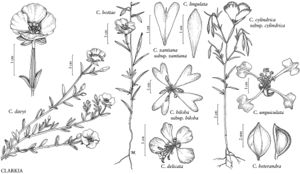Clarkia bottae
Madroño 12: 33. 1953.
Stems erect, to 100 cm, glabrous, glaucous, rarely puberulent. Leaves: petiole to 5 mm; blade narrowly lanceolate to lanceolate, 3–10 cm. Inflorescences open racemes, axis straight in bud; buds pendent. Flowers: floral-tube 2–3 mm; sepals reflexed together to 1 side; corolla bowl-shaped, petals pale lavender to pinkish lavender, often white toward base, usually red-flecked, unlobed, 15–30 mm; stamens 8, unequal, outer anthers lavender, inner smaller, paler; ovary obscurely 4-grooved; stigma exserted beyond anthers. Capsules 30–40 mm; pedicel 0–30 mm. Seeds brown or gray, 1.2–1.8 mm, ± papillose, crest 0.2 mm. 2n = 18.
Phenology: Flowering Apr–Jul.
Habitat: Chaparral, woodlands, coastal scrub.
Elevation: 0–1000 m.
Discussion
Clarkia bottae is known from the Outer South Coast Ranges from Monterey and San Benito to Santa Barbara counties, throughout southwestern California, and more sporadically in the southern Sierra Nevada in Fresno and Kern counties. Reports from Del Norte, Madera, and Napa counties have not been verified.
Clarkia bottae is most closely related to C. jolonensis and may be closely related to C. xantiana; all three have 2n = 18, and spontaneous hybrids were formed when C. bottae was grown adjacent to a natural population of C. xantiana.
Selected References
None.
